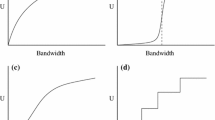Abstract
In this paper, we investigate the problem of determining the optimal bandwidth allocation for a Dynamic Bandwidth Allocation Scheme (DBAS). The objective is to minimize the total amount of bandwidth required to satisfy the Quality of Service (QoS) requirements of all traffic streams. It is shown that when the performance functions satisfy a certain number of conditions, there exists a unique optimal bandwidth allocation such that, for each traffic stream, either its QoS is just satisfied or its QoS is over-satisfied and it is allocated zero bandwidth. Such an allocation is said to be efficient. It is also shown that there exists a unique efficient allocation in the entire feasible region. An iterative algorithm is developed to compute the efficient allocation employing its special properties. Numerical examples are presented to demonstrate how the algorithm works. Future extensions of this work are also discussed.
Similar content being viewed by others
Explore related subjects
Discover the latest articles, news and stories from top researchers in related subjects.References
M.S. Bazaraa, H.D. Sherali and C.M. Shetty,Nonlinear Programming (Wiley, New York, NY, 1983).
J.H.S. Chan and D.H.K. Tsang, Comparison of static and dynamic bandwidth allocation schemes for multiple QoS classes in ATM networks,Proc. IEEE Singapore Int. Conf. on Communication Systems (ICCS'94), Singapore (1994) pp. 728–732.
M. Decina, T. Toniatti, P. Vaccari and L. Verri, Bandwidth assignment and virtual call blocking in ATM networks,Proc. INFOCOM'91, Bal Harbour, FL (1991) pp. 881–888.
A. Demers, S. Keshav and S. Shenker, Analysis and simulation of a fair queueing algorithm, J. Internetworking: Res. and Experience (1990)3–26.
A.A. Lazar, A. Temple and R. Gidron, An architecture for integrated networks that guarantees quality of service, Int. J. Digital and Analog. Commun. Syst. 3(1990)229–238.
Y. Miyao, A call admission control scheme in ATM networks,ICC'91 (1991) pp. 391–396.
Y. Miyao, Bandwidth allocation in ATM networks that guarantee multiple QoS requirements,ICC'93 (1993) pp. 1398–1403.
T. Murase, H. Suzuki and T. Takeuchi, A call admission control for ATM networks based on individual multiplexed traffic characteristics,ICC'91 (1991) pp. 193–198.
J. Nagle, On packet switches with infinite storage, IEEE Trans. Commun. 35(1987)435–438.
A.K. Parekh and R.G. Gallager, A generalized processor sharing approach to flow control in integrated services networks: The single node case, IEEE/ACM Trans. Networking 1(1993)344–357.
A.K. Parekh and R.G. Gallager, A generalized processor sharing approach to flow control in integrated services networks: The Multiple node case, IEEE/ACM Trans. Networking 2(1994)137–150.
K. Sriram, Dynamic bandwidth allocation and congestion control schemes for voice and data multiplexing in wideband packet technology,ICC'90 (1990) pp. 1003–1009.
K. Sriram, Methodologies for bandwidth allocation, transmission scheduling, and congestion avoidance in broadband ATM networks,GLOBECOM'92 (1992) pp. 1545–1551.
Y. Takagi. S. Hino and T. Takahashi, Priority assignment control of ATM line buffers with multiple QOS classes, IEEE J. Select. Areas Commun. 9(1991)1078–1092.
T. Yang and H. Li, Individual cell loss probabilities and traffic interference in ATM networks,ICC'93, Geneva, Switzerland (1993).
O. Yaron and M. Sidi, Generalized processor sharing networks with exponentially bounded burstiness arrivals,IEEE INFOCOM'94 (1994) pp. 628–634.
J. Yei, Performance evaluation and bandwidth allocation for ATM-based B-ISDNs, M.A.Sc., Department of Industrial Engineering, Technical University of Nova Scotia (1993).
J. Yei and T. Yang, Cell loss performance of a dynamic bandwidth allocation scheme for ATM-based B-ISDN,Proc. Australian Telecommunication Networks & Applications Conf. 1994, Melbourne, Australia (1994).
Z. Zhang, D. Towsley and J. Kurose, Statistical analysis of generalized processor sharing scheduling discipline,Proc. SIGCOMM'94 (1994) pp. 68–78. (A revised version to appear in IEEE JSAC on: Advances in the Fundamentals of Networking.)
Author information
Authors and Affiliations
Additional information
Partially supported by NSERC of Canada through grants OGP14020 and STRIN-200.
Rights and permissions
About this article
Cite this article
Yang, T., Yei, J. Optimal solutions for a dynamic bandwidth allocation scheme in high-speed networks. Telecommunication Systems 5, 389–412 (1996). https://doi.org/10.1007/BF02112524
Received:
Revised:
Issue Date:
DOI: https://doi.org/10.1007/BF02112524




